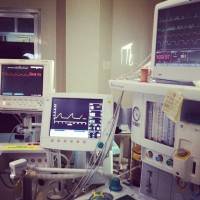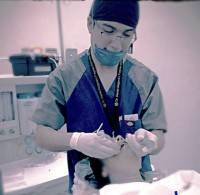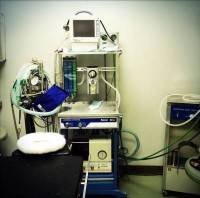Anesthesia Complications Breast Enlargement
The type of anesthesia for breast augmentation is not as important as who is doing the anesthesia for your procedure.
You want to make sure that a board certified anesthesiologist is doing your anesthesia whether it is sedation or general. I personally do all of my breast augmentations under general anesthesia.
Questions to ask: 1.Where is the surgery performed. Is the procedure performed in an accredited surgery center or hospital?
2.Who performs the anesthesia for the procedure?
a.Is an anesthesiologist performing the anesthesia? (Johnny Franco, MD, Miami Plastic Surgeon)
Anesthetic and Breast Augmentation

Anesthesia for breast augmentation surgery
Different doctors have differing opinions on which type is best. This is probably not the most important factor in your choice of surgeon, although it is still something to consider. What’s most important is that you can feel confident and comfortable with the plastic surgeon you choose.
They should be highly experienced and board certified with an excellent track record of delivering safe, beautiful results, and you should feel as though you’re on the same page in terms of your goals and expectations for this procedure.
If you do not have a preference and there is no medical reason that either type is not suitable for you, don’t let this get in the way of choosing the best surgeon for you. (Frank Lista, MD, Toronto Plastic Surgeon)
Anesthesia for Breast Augmentation

Anesthesia for breast augmentation photo
I believe the most important thing is choosing your surgeon and anesthesia provider. In the proper setting and by well trained physicians both general anesthesia and IV sedation are extremely safe and effective ways to perform breast augmentation.
Surgeons generally have a preference as to which way works better for them in their practice, but that does not mean that the other way is wrong for another surgeon.I prefer general anesthesia because I prefer complete muscle relaxation (which requires GA) even when I am using a pocket above the muscle.
For me muscle relaxation causes less bleeding and a more accurate pocket dissection. Patients are pre-medicated with anti-nausea medication and the relaxation well timed during the surgery so that patients do not have increased nausea or a prolonged stay in the recovery area.

Anesthesia for breast augmentation procedure
But just because that protocol works well for me and my patients in my setting does not mean that IV sedation does not work well for others. I would focus on choosing your surgeon rather than the type of anesthesia you will receive. (Michael B. Tantillo, MD, Boston Plastic Surgeon)
Different surgeons prefer different techniques. You should choose the surgeon that you trust and let them use the technique that they always use. It is best to fit yourself into their system, because it is what works for them. I prefer to use a board certified anesthesiologist who administers general anesthesia. The operation is relatively short and the risk of anesthesia are low. If you are asleep then everything goes very smoothly. (Gary Lawton, MD, FACS, San Antonio Plastic Surgeon)
General anesthesia for breast augmentation
I use general anesthesia for breast augmentation – it is a quick procedure and young, healthy people, such as you, recover rapidly. Both methods can be used safely – as long as anesthesia is administered by a licensed professional. Ultimately, choose the surgeon, facility, and staff you are more comfortable with. Best of luck. (Grant Stevens, MD, Los Angeles Plastic Surgeon)
Anesthesia for breast augmentation surgery
Both general anesthesia and IV sedation are safe forms of anesthesia when administered by a board certified anesthesiologist.
The type of anesthesia will vary by the doctor, facility, and equipment available.
Although I have used both kinds of anesthesia I personally prefer general anesthesia. (Christopher J. Davidson, MD, FACS, Boston Plastic Surgeon)
Anesthesia options for breast augmentation
There is no single best answer to the optimal choice of anesthesia – IV sedation plus local or general – but one thing that is certain is that wide awake under local only is a bad idea.
If the facility is accredited then there should be some options available to discuss for your comfort and safety. Choose the surgeon you are most comfortable with and trust them to make an appropriate anesthesia recommendation. (Richard Baxter, MD, Seattle Plastic Surgeon)
General vs IV sedation for breast augmentation
The answer to your question is that both work equally well. We use general anesthesia when performing endoscopic breast augmentation and IV sedation for all others.
I believe that both are equally safe, and would base your decision on which surgeon you feel most comfortable with. I would try to find out which has the better reputation and does the most augmentations. (Robert M. Jensen, MD, Medford Plastic Surgeon)
You will find different opinions on this issue, and I am on the side of general anesthesia. IV sedation is understandably attractive because it sounds safer. However, if you are having your breast implants placed under the muscle, it is difficult to get the muscle completely numb and in order to get through it you will need a deep IV sedation. I have asked many anesthesiologists this question, and the constant answer has been that they would feel safer with a general anesthesia because the anesthesiologist has complete control of your airway and breathing. For a young and healthy person serious risks or complications of general anesthesia are rare, no more common than the risks of IV sedation and probably less. (Joseph Fata, MD, Indianapolis Plastic Surgeon)
If your are getting your implants placed under the muscle then general anesthesia is the way to go. If they are on top of the muscle you could go either way. Make sure that whoever is administering your anesthesia is an anesthesiologist or an experienced CRNA, not the surgeon performing the procedure! (Marcel Daniels, MD, Long Beach Plastic Surgeon)
Anesthesia for Breast Augmentation
Each surgeon has their own preference as to the way surgery is done as well as what type of anesthesia is used. My advise for you is to do your homework. Make sure your surgeon is board certified by the American Board of Plastic Surgery and has privileges to perform this surgery at an accredited hospital or surgery center.
Ask who will be responsible for your anesthesia, If surgery is performed in the office – is it an accredited facility. Choose the surgeon you feel has the most experience, highest references and you feel most comfortable with and then you need to feel comfortable putting you in their hands. (Albert Dabbah, MD, Boca Raton Plastic Surgeon)
Both general and i.v. sedation are acceptable means of anesthesia in breast augmentation procedures. General anesthesia is my preference since I use muscle relaxation during the procedure to help with implant placement, which you can not do with sedation and local infiltration alone.
I also feel there is greater safety by having complete control of the airway during the procedure . (William F. DeLuca Jr, MD, Albany Plastic Surgeon)
I prefer a general anesthetic so the airway is safe, the ptient may be relaxed so that less trauma occurs during the surgery and the dissection is as delicate as possible. You should really go with what method your surgeon is most comfortable doing and of course a detailed discussion of pros and cons with the anesthesia should be discussed either with the surgeon or anesthesia provider. (Matthew H. Conrad, MD, Wichita Plastic Surgeon)
Concerns about anesthesia are common for many patients. I have performed breast implants with both types of anesthesia.
They both work, but over the years I have found that I prefer using general anesthesia for breast implants. The patients are completely asleep and have no memory of the surgery and experience no discomfort.
During general anesthesia, an airway is placed which allows the anesthesiologist or nurse anesthetist to better control the patient’s airway and breathing.
Local anesthetic is also injected which means our patients wake up quickly from the anesthesia and they are very comfortable. (Christopher J. Morea, MD, Raleigh-Durham Plastic Surgeon)
When decided which doctor to go with based on what type of anesthesia they use, I would suggest that you look at their before and after pictures.
It is the end result that matters: a beautiful, safe, and long lasting results. As to the anesthesia question, either one can be used and you should choose the type of anesthesia that your surgeon is most commonly using when performing breast augmentation implants. While both may be possible, to try to get a surgeon to use a type of anesthesia that he / she doesn’t normally use will cause a distraction during the procedure and you want to make sure that everything taking place during your surgery is ‘routine’.
A surgeon using an ‘older’ technique which he/she has performed a 1000 times is more likely to to have a complication-free experience than a surgeon using the latest/most advanced technique which he/she has done only 5 times. (Martin Jugenburg, MD, Toronto Plastic Surgeon)
Personally, I prefer general anesthesia for this one-hour operative procedure as it will maximize patient comfort and safety and maximize intraoperative control for doing a breast implants. It also depends on the region of the country. I reside in Dallas, TX and general anesthesia is the preferred agent. I also think it is safer as you have much better control of the airway. I only use Board Certified Anesthesiologists to perform this procedure. (Rod J. Rohrich, MD, Dallas Plastic Surgeon)
Sedation for Breast Augmentation
The majority of surgeons prefer to use general anesthesia versus IV sedation for breast implants, though both are acceptable for the type of procedure you want performed.
General anesthesia is generally much easier for the patient. General anesthesia today is very safe and allows the patient to not experience waking or discomfort during the surgery. (Jeffrey W. Hall, MD, Austin Plastic Surgeon)
I also prefer to perform my breast augmentation procedures under general anesthesia. I believe this method is very safe and effective for my patients. My anesthesia is performed by a board-certified, m.d., anesthesiologist as opposed to a nurse anesthetist or RN. Another benefit for having my patients under general anesthesia is that I can have my anesthesiologist give my patients muscle relaxants that allow me to avoid any muscular contractions while I am dissecting the pocket with my cautery device. I imagine that surgeons who perform breast implants under IV sedation must be utilizing blunt and blind dissection techniques as they wouldn’t care about any muscle contractions during surgery. (Sanjay Grover, MD, Orange County Plastic Surgeon)
I believe GA is the safest overall option. Clearly, this is a matter of debate. In my region (Canada), almost all BBAs are done with GA. (Asif Pirani, MD, FRCS(C), Toronto Plastic Surgeon)
General anesthesia comes in many flavors but the two important distinctions are general anesthesia without muscle paralysis, and general anesthesia with muscle paralysis.
When you need muscle paralysis to relax the muscles in abdominal surgery, or reducing bone fractures, it is the appropriate choice. Also, if you need complete control of respiration.
An endotracheal tube is inserted into the trachea. Patients are fatigued for weeks following long procedures with this general anesthesia Most cosmetic procedures due not require muscle paralysis.
A light anesthetic is introduced through an LMA (laryngeal mask airway) in combination with IV sedatives. This is “light general anesthesia” without paralysis.
Patients are fatigued for days following this anesthesia, usually related to time and extent of breast surgery. There are may variations of IV sedation.
Versed and Diprovan are the most effect and expensive. Patients breath on their own, but are fully asleep. A patient can be awakened, spoken to, and put back to sleep with a turn of the dial on the Diprovan pump. There is an amnesic effect, so they remember nothing. Post-operative fatigue is minutes to hours. Very safe as long a pump is used. Michael Jackson died because no pump was used to administer his Diprovan. Heavy drinkers and patients on pain management with narcotics may be resistant to this and are better controlled with light general. Valium and Ketamine have been used very safely, but patients can wake up and some get spooked by the Ketamine. Fast recovery also. The bottom line is that the best trained surgeons will chose the anesthesia that is best suited to the patient and the surgery at hand. One size does not fit all in quality care. (Luis Villar, MD, West Palm Beach Plastic Surgeon)
It is the experience of the doctor that matters. Make sure this is not a “cosmetic” surgeon but a board certified plastic surgeon. Any doctor can do the breast surgery in their own office operating room with IV sedation be careful who you chose (Jed H. Horowitz, MD, FACS, Orange County Plastic Surgeon)
Anesthesia for breast surgery
I wish it was that easy to say do one type of anesthesia and not the other but it is not. The best anesthesia for a given procedure is dependent on what is being done at surgery, the patient’s personal pain and sitting still thresholds and the experience of the surgeon and anesthesia staff. For 2 different people having the same procedure the best anesthesia for each may be quite different. Last year I performed liposuction of the body on a patient who had previous neck surgery for cancer and breathed through a hole in the throat.
One anesthesiologist refused to use spinal anesthesia and another believed it was the best way to go. We did the spinal anesthesia and the patient sailed through the surgery. In retrospect spinal anesthesia was the best option for that patient but would not be in the majority of patients.
Just because you can do something does not mean you should. Awake breast surgery has a definitive role in the armamentarium but by itself is not inherently better or worse than another type of anesthesia, it depends on the circumstances.
I can see your point of being turned off by the surgeon who bases their decision more on bad mouthing the techniques they do not use than justifying the those they do use. My suggestion would be to speak to the person supplying the anesthesia and ask them the reason for using a particular form of anesthesia. If the answer is solely cost or lack of certification of the operating facility to give general anesthesia you need to run in the other direction.
If the surgeon and anesthesia staff are the same person that is a definite red flag and you should run not walk to the nearest exit.
I hope you realize that this format of posting questions and receiving answers lacks the face to face direct communication required for you to make an informed decision regarding your surgery. My response to your question/post does not represent formal medical advice or constitute a doctor patient relationship.
You need to consult with i.e. personally see a board certified plastic surgeon in order to receive a formal evaluation and develop a doctor patient relationship. (Aaron Stone, MD, Los Angeles Plastic Surgeon)
Both breast implants anesthesia types are safe if done in an accredited surgical facility by an M.D. anesthesiologist or C.R.N.A.
You should choose th board certified plastic surgeon you feel most comfortable with.
You might want to review their before and after photo albums, ask about complications, how are these handled and does your surgeon have hospital privileges for your surgery. (George Marosan, MD, Charlotte Plastic Surgeon)
Both iv sedation and general breast implants anesthesia are reasonable alternatives for breast implants. We have used both in our AAAASF certified OR for several years, but currently use general anesthesia.
One of the key issues with any type of anesthesia is how competent and comfortable the anesthesia provider is with the technique used.
General breast implants anesthesia has benefits that include better protection of the airway and a deeper level of anesthesia. I have not found any difference in awakening times, recovery, postop pain, or other specific issues between iv sedation and general anesthesia. The drugs and techniques for both general anesthesia and sedation can vary significantly from provider to provider.
Discuss these issues with your surgeon (and anesthesia provider) before surgery to evaluate their experience, technique, and expertise. (Eric T. Emerson, MD, FACS, Los Angeles Plastic Surgeon)
General or IV sedation breast implants anesthesia?
Any type of anesthesia can be safe or unsafe, depending on who is administering it and monitoring you. I would recommend focusing on the qualifications and credentials of the plastic surgeon, the anesthesiologist, and the facility rather than the type of anesthesia, since many surgeries can be safely done under either.
And remember, IV sedation can be light or very deep – bordering on general anesthesia but without airway protection.
You can always ask to speak to the breast implants anesthesia provider for more information and to help answer your questions – our anesthesiologist always calls patients a couple days ahead of time to go over health history, medications and answer questions. (Michelle Spring, MD, Chicago Plastic Surgeon)
You will find that both are good and safe for breast implants. We happen to use sedation, though there is not a right or wrong answer. A better question to ask might be who will be providing the service, and where will your surgery be performed. The facility should be accredited and regularly peer reviewed, and the anesthesia provider properly credentialed. Best of luck. (Peter E. Johnson, MD, )




